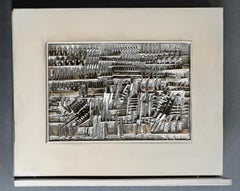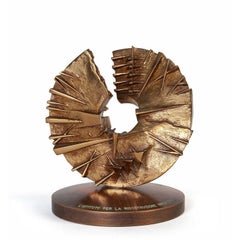Want more images or videos?
Request additional images or videos from the seller
1 of 3
Arnaldo PomodoroArnaldo Pomodoro (1926) – Elemento 1 (Stele) per Fiat – Silver-plated bronze1983
1983
$6,135.27List Price
About the Item
- Creator:Arnaldo Pomodoro (1926, Italian)
- Creation Year:1983
- Dimensions:Height: 6.89 in (17.5 cm)Width: 1.97 in (5 cm)Depth: 0.99 in (2.5 cm)
- Medium:
- Movement & Style:
- Period:
- Condition:vey good conditions.
- Gallery Location:Varese, IT
- Reference Number:1stDibs: LU1938216448862
About the Seller
5.0
Vetted Professional Seller
Every seller passes strict standards for authenticity and reliability
Established in 2020
1stDibs seller since 2022
81 sales on 1stDibs
Typical response time: 1 hour
Authenticity Guarantee
In the unlikely event there’s an issue with an item’s authenticity, contact us within 1 year for a full refund. DetailsMoney-Back Guarantee
If your item is not as described, is damaged in transit, or does not arrive, contact us within 7 days for a full refund. Details24-Hour Cancellation
You have a 24-hour grace period in which to reconsider your purchase, with no questions asked.Vetted Professional Sellers
Our world-class sellers must adhere to strict standards for service and quality, maintaining the integrity of our listings.Price-Match Guarantee
If you find that a seller listed the same item for a lower price elsewhere, we’ll match it.Trusted Global Delivery
Our best-in-class carrier network provides specialized shipping options worldwide, including custom delivery.You May Also Like
Lake Erie and Other Waters 03
By Roberley Bell
Located in Buffalo, NY
An original unique bronze and silver leaf abstract sculpture by Roberley Bell.
This dynamic work from the artist's "Lake Erie and Other Waters" series can...
Category
1990s Abstract Abstract Sculptures
Materials
Silver, Bronze
Lake Erie and Other Waters 02
By Roberley Bell
Located in Buffalo, NY
An original unique bronze and silver leaf abstract sculpture by Roberley Bell.
This dynamic work from the artist's "Lake Erie and Other Waters" series can...
Category
1990s Abstract Abstract Sculptures
Materials
Bronze, Silver
Silver wall sculpture
By Michael Davis
Located in Palm Desert, CA
Silver From the series, Elements, this sculpture references the Bolivian mines that produce much of the worlds silver production ARTIST'S STATEMENT Michael Davis My sculptures and...
Category
21st Century and Contemporary Abstract Sculptures
Materials
Metal, Silver
Silver Sculpture 'Curva I' by Carola Eggeling
By Carola Eggeling
Located in Paris, FR
Silver Sculpture 'Curva I' by Carola Eggeling
Abstract sculpture with beautiful curved lines.
German silver sculpture
Silver - Alpaca
Certificate of authenticity
Numbered and signe...
Category
21st Century and Contemporary Abstract Abstract Sculptures
Materials
Silver
$8,023
H 10.24 in W 13.39 in D 4.73 in
Silver Sculpture 'Phönix I' by Carola Eggeling
By Carola Eggeling
Located in Paris, FR
Silver Sculpture 'Phönix I' by Carola Eggeling
Abstract sculpture with beautiful curved lines.
German silver sculpture (alloy of copper, nickel and zinc)
Numbered and signed artwork...
Category
21st Century and Contemporary Abstract Abstract Sculptures
Materials
Silver
$10,146
H 13.39 in W 5.12 in D 8.27 in
Silver Sculpture 'Curva II' by Carola Eggeling
By Carola Eggeling
Located in Paris, FR
Silver Sculpture 'Curva II' by Carola Eggeling
Abstract sculpture with beautiful curved lines.
German silver sculpture
Silver - Alpaca
Certificate of authenticity
Numbered and sign...
Category
21st Century and Contemporary Abstract Abstract Sculptures
Materials
Silver
$9,556
H 13.39 in W 11.82 in D 11.42 in
Opus 531
By Robert Klippel
Located in Zug, CH
A unique cast in silver of a Robert Klippel Opus.
Category
Mid-20th Century Abstract Abstract Sculptures
Materials
Silver
Untitled Steel Mesh 2012, Abstract Geometric Wall Sculpture by Jin-Sook So
By Jin-Sook So
Located in Wilton, CT
Untitled Steel Mesh I 2012, Jin-Sook So, steel mesh, painted, electroplated silver and gold leaf, 31.5" x 52.75" x 6.25", 2012.
This abstract geometric wall sculpture was done by fi...
Category
2010s Abstract Geometric Abstract Sculptures
Materials
Silver, Steel, Gold Leaf
$50,000
H 31.5 in W 52.75 in D 6.25 in
"Folded Form I" Abstract-Geometric Contemporary Korean Wall Sculpture
By Jin-Sook So
Located in Wilton, CT
"Folded Form I", steel mesh, painted, electroplaited, gold and silver leaf, 12 1/4" x 12 1/4" x 12 1/4", 2004.
This abstract geometric wall sculpture was done by fiber artist, Jin-S...
Category
Early 2000s Abstract Geometric Abstract Sculptures
Materials
Metal, Silver, Steel, Gold Leaf
$3,600
H 12.25 in W 12.25 in D 12.25 in
"Pojagi Construction I" Jin-Sook So, Contemporary Korean mixed media artwork
By Jin-Sook So
Located in Wilton, CT
This abstract geometric mixed media piece was done by fiber artist, Jin-Sook So (b. 1950, Korea). So grew up in Seoul, Korea where she received a master's degree in textile art, afte...
Category
Early 2000s Abstract Geometric Abstract Sculptures
Materials
Metal, Silver, Steel, Gold Leaf
$6,400
H 21.25 in W 19.75 in D 2.25 in
More From This Seller
View AllArnaldo Pomodoro (1926 - 2025) - Bassorilievo - Silver sculpture - 1968
By Arnaldo Pomodoro
Located in Varese, IT
Silver sculpture with chrome-plated brass
Executed in 1968, work produced in 2 copies + 1 artist's proof
Dimension of the work: 29 x 35.5 x 7 cm
signature engraved on the lower right...
Category
1960s Abstract Sculptures
Materials
Silver, Brass
Arnaldo Pomodoro (1926 - 2025) - Bassorilievo - Silver sculpture - 1973
By Arnaldo Pomodoro
Located in Varese, IT
Silver sculpture with chrome-plated brass
Executed in 1973, work produced in 2 copies + 1 artist's proof
Dimension of the work: 24.8 x 18.5 x 8 cm
signature engraved on the lower rig...
Category
1970s Abstract Sculptures
Materials
Silver, Brass
Arnaldo Pomodoro ( 1926 ) - Rotazione Ascensoriale - Bronze Sculpture - 1993
By Arnaldo Pomodoro
Located in Varese, IT
Rotazione Ascensoriale I , 1993
bronze sculpture h15 x 12.5 x 8 cm approx , ( including base ) , diameter Ø approx 13.5 cm
limited edition , numbered: 15/70
signed dated and numbered...
Category
1920s Abstract Geometric Abstract Sculptures
Materials
Bronze
Lucio Fontana (1899-1968) - Lucio Fontana's metal sculpture commissioned in 1964
By Lucio Fontana
Located in Varese, IT
Lucio Fontana's metal sculpture commissioned in 1964 by Alfa Romeo, a machined and pierced steel disk, with an affixed smaller disk engraved 'Alfa Romeo Milano a Maria Teresa Meneghe...
Category
1960s Abstract Sculptures
Materials
Steel
Wifredo Lam (1902–1982) - L’Oiseau de fer and L’Oiseau de feu - Brass and chrome
By Wifredo Lam
Located in Varese, IT
Two multiple sculptures in limited edition (brass and chrome-plated brass)
Limited edition of 500 copies
Both with inscribed signature and numbered 99/500A and 99/500B
Sculpture size...
Category
1970s Abstract Sculptures
Materials
Brass
Allen Jones (1937) - Legs - sculpture in resin - 1937
By Allen Jones
Located in Varese, IT
Resin sculpture, edited in 1937
Limited edition 2000 copies , numbered 26/2000
Signed in pencil by artist
Sculpture size: 36 x 63 x 13 cm
Fair conditions, the work has cracks
A regu...
Category
1930s Abstract Sculptures
Materials
Resin

